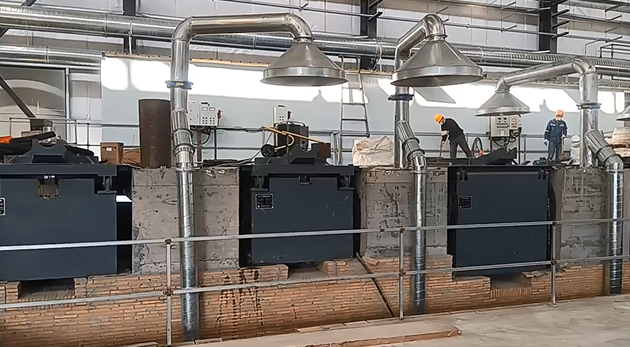How does the medium frequency induction furnace smelt metal
As a manufacturer of industrial furnaces, we produce many medium frequency induction furnaces.
Medium frequency induction heating has the characteristics of fast heating, uniform heating, non-contact heating, no pollution, small operation area and high productivity, so it is used in many fields such as surface quenching of industrial metal parts, metal melting, bar heat penetration, etc. It is becoming more and more widespread, so do you know what the principle of medium frequency induction heating is?
The principle of intermediate frequency induction heating is to use the method of electromagnetic induction. When the magnetic flux surrounded by the conductor loop changes, an induced potential will be generated in the loop.
The conductor in the alternating magnetic field also generates an induced potential under the action of electromagnetic induction, and an induced current is formed in the conductor. The induced current overcomes the resistance of the conductor itself to generate Joule heat, and this heat is used to heat the conductor itself, causing it to heat up and melt. To achieve a variety of thermal processing purposes.
The basic components of an induction heating system include an induction coil, an AC power source and a workpiece. Depending on the heating object, the coil can be made into different shapes.
The coil is connected to the power supply, the power supply provides alternating current for the coil, and the alternating current flowing through the coil generates an alternating magnetic field passing through the workpiece, and the magnetic field causes the workpiece to generate eddy current to induce heating.
There are three AC applications in medium frequency induction heating:
On the surface, when the conductor is put into the inductor, an alternating magnetic field is generated to generate an induced current of the same frequency in the workpiece conductor. The distribution of this induced current in the workpiece is uneven, strong on the surface, but very weak inside. To the heart is close to 0, mainly to rapidly heat the surface of the part, and even the fruit that melts through heat.
Adjacent response, when two adjacent conductors are connected with alternating current, the current in the conductors should be redistributed. When the two currents are reversed, the currents are concentrated on the inside of the conductors, and when the currents are in the same direction, they are discharged on the outside of the conductors.
The ring should, when the alternating current passes through the circular solenoid, the larger current appears on the inside of the coil conductor.
The induction coil itself shows a ring response, the furnace body shows a surface response, and there is a proximity response between the two.
Induction uses the principle of electromagnetic induction, heat is generated in the workpiece itself, and the heating method has a fast heating rate, so the heating rate is high, the process repeatability is good, and it is more energy-saving.
The heating object does not need to be in contact with the induction coil, so the oxidation decarbonization is less and the heating rate is higher.
The medium frequency induction heating uses three kinds of AC applications: surface, proximity, and ring. It can do local heating, and the product quality is good, and it is easy to control and labor-saving.
The temperature control precision is high, the induction heating is easy to achieve uniform heating, and the temperature difference between the core and the surface is small. The application of temperature control system can realize temperature control, low energy consumption and no pollution.
Compared with other heating methods, induction heating has the advantages of high heating rate, energy saving, no pollution, small operation area and high productivity.
Induction heating is a very popular method in the market today. You can follow Luoyang Hongteng and ask questions about induction furnaces.
Video of the use process of the furnace


